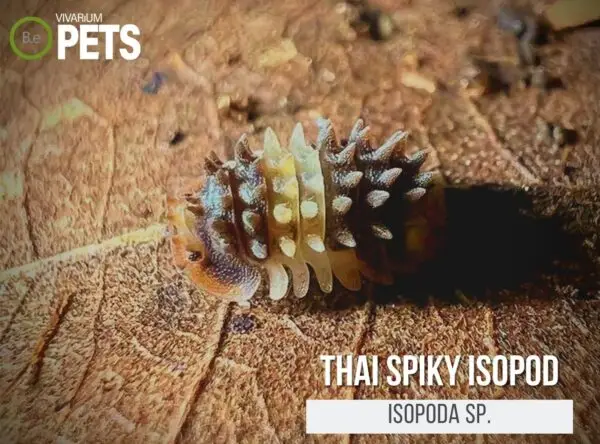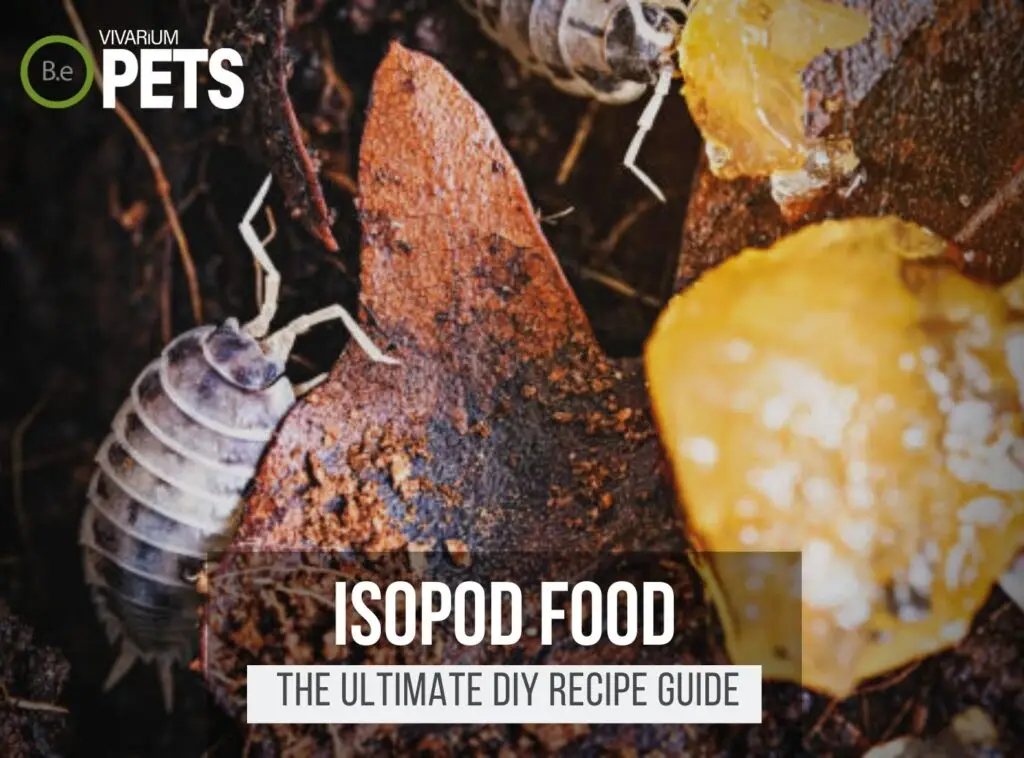Are you looking for a unique pet to add to your family? Consider the Thai Spiky Isopod, an interesting and relatively easy pet to care for!
This guide will provide an overview of the Thai Spiky Isopod and the essential needs for a healthy and happy pet.
Learn about the natural environment of the spiky isopod, creating an appropriate enclosure, types of food to feed, and how to maintain a healthy environment for your pet.
Follow these simple steps to ensure that your Thai Spiky Isopod thrives!
Table Of Contents:
ToggleWhat Are Thai Spiky Isopods?
Thai Spiky Isopods, also known as Thailand Spiky Isopods, are a species of isopods that have literal spikes covering their exoskeleton.
They are commonly found near lakes, rivers, and streams. The common name was derived from their spiky appearance and the fact that they appear to “dance” when threatened.
Thai Spiky Isopods have transparent bodies with black, red, and white spots, giving them a spotted and striped look.
Create an ideal habitat for your Thai Spiky Isopods with our Customizable Isopod Terrarium Kits, which include everything you need to get started.
What Do Thai Spiky Isopods Look Like?
Thai Spiky Isopods, scientifically known as Isopoda sp., has a striking appearance with little spiky horns. They are located around the eyes, the back of the head, as well as the rest of the upper body.
They are most commonly seen with a dark brownish color but may also appear in shades of black, gray, and green.
They have several pairs of legs that are used predominantly for crawling and maneuvering through their environment.
Their coloring along with the spikes make them unique when compared to other isopod species.
Additionally, the underside of their bodies is smooth and is generally a lighter shade of yellow.
Benefits Of Using Thai Spiky Isopods
The Thai Spiky Isopod will help clean up any uneaten food or decaying organic matter that accumulates in the tank, keeping the enclosure they inhabit clean and clear.
Furthermore, they will help aerate the substrate, which is important for providing oxygen for the plants and other life in the tank.
Additionally, they provide food for many other creatures that inhabit the tank, allowing for a more balanced and diverse ecosystem in the vivarium.
Finally, these little critters are fascinating to watch and can add an enjoyable, interactive element to a terrarium.


Thai Spiky Isopod Facts
Isopoda sp. is a small crustacean that is native to Thailand and surrounding areas.
They have an omnivorous diet, meaning they feed on both plant material and small insects.
They are generally easy to care for and have a lifespan of around 1 to 3 years if properly cared for.
Habitat
The Thai Spiky Isopod is commonly found near shallow waters and on soft substrates. Partially submerged rocks, logs, and other fallen debris provide shelter for these isopods.
While the Thai Spiky Isopod does prefer the warm waters of the tropics, it can be found in other climatic regions.
The Thai Spiky Isopod typically remains in one place throughout its lifetime, although it will move from one shady spot to another if disturbed.
Replicate their natural habitat perfectly with our Bioactive Isopod Substrate Blend, designed to provide the ideal moisture and organic content for your isopods.
Diet
Isopoda sp. is a terrestrial species that primarily rely on organic matter such as dead leaves and other decaying plant material as well as small insects such as worms and slugs for their diet.
They are also capable of adapting to their environment and have been observed to scavenge on decaying fish and other small crustaceans as well.
Maintaining a healthy diet is essential for the health and well-being of these isopods.
Because Thai Spiky Isopods are closely related to other species of isopods, they are also capable of foraging on decaying plant matter such as fungus and algae.
This generally helps to provide them with the nutritional needs necessary to remain healthy.
Temperament
The temperament of Thai Spiky Isopods can vary greatly depending on the individual animal. Generally, they are not known to be aggressive toward humans or other animals.
They are not known to be particularly cuddly either and will often scurry away when disturbed.
Thai Spiky Isopods are generally shy and prefer to be left alone, though they may become comfortable with gentle handling with regular interactions.
They enjoy being in groups, so if several of them together in an enclosure, they may show signs of the community such as sharing food.
It is important to note that Thai Spiky Isopods are not usually suitable as petting animals and should not be handled roughly.
Lifespan
Thai Spiky Isopods have a long lifespan of up to 3 years – if they’re provided with the right environment and care.
The life cycle of a Thai Spiky Isopod starts when the female lays eggs, which hatch in around two weeks depending on the temperature of their environment.
The eggs then go through six juvenile stages before reaching adulthood and sexual maturity.
Where To Find Thai Spiky Isopods
Finding Thai Spiky Isopods in the wild requires some level of research, as they are largely restricted to Thailand and nearby locations.
Look for local vendors or hobbyist groups who may have access to these rare creatures.
Alternatively, you can search online for reputable Thai Spiky Isopod breeders and sellers or purchase captive-bred specimens from isopod farms.
If you decide to capture your own Thai Spiky Isopod from the wild, be sure to take the necessary precautions to ensure the safety and health of the specimen.
Consider looking for environments that are peaceful and quiet, away from the disturbances and disturbances of humans and animals.
When capturing the Thai Spiky Isopod, use an appropriate-sized container to ensure that the isopod has enough room to move without getting hurt or stressed.
Also, be sure to research pest control methods in your area to ensure the safety of the wild isopod in its environment.
Thai Spiky Isopod Care
To care for Thai Spiky Isopods, create an appropriate enclosure to replicate their natural environment.
You should also feed them a variety of food, and maintain a healthy environment to ensure their health and well-being.
Ensure their enclosure has plenty of hiding places and maintain their food schedule to ensure they are healthy and happy.
Tank Requirements
When setting up an ideal tank environment for Thai Spiky Isopods, it is important to keep in mind their natural habitat and make sure to mimic it as much as possible.
To do this, a terrarium-type setup with a secure lid should be utilized to help keep humidity levels in check and ensure the isopods’ safety.
Regarding water parameters, a pH level of 6-7 and hardness of 4-7°dh is ideal for these isopods. Furthermore, temperatures should stay within the range of 70-85°F.
The terrarium substrate should usually consist of a mix of coco peat, sphagnum moss, and other organic soil to create the natural environment they would find in the wild.
The tank should also be equipped with soft terrarium lighting and some cave-like areas for the isopods to hide in when needed.
By following these steps you can ensure that the Thai Spiky Isopods in your tank will be kept happy and healthy for years to come.
What Do Thai Spiky Isopods Eat?
Feeding Thai Spiky Isopods is relatively easy, as they are scavengers with a varied diet. They can be fed a variety of fruits, vegetables, and various types of small insects. Here is a list of things you can feed them:
- Vegetables such as cucumber, carrots, and mushrooms
- Fruits such as apples, bananas, and melons
- Shrimp pellets or other commercial isopod foods
- Leaf litter from a variety of trees and other plants
It is important to ensure that all the food given to the Thai Spiky Isopods is fresh and non-toxic and cannot harm the isopod.
Feed your Thai Spiky Isopods 3-4 times a week and make sure that the food is always of high quality.
If you’re more of an avid hobbyist like myself, be sure to check out my ultimate DIY Isopod food guide. I give a more in-depth explanation of the best foods and my favorite recipe.
Best Tankmates For Thai Spiky Isopods
Thai Spiky Isopods are best kept with other animals that have similar dietary and environmental needs.
These include other species of isopods, such as cubaris isopods, and Armadillidium species.
Additionally, springtails will also make good tankmates for Thai Spiky Isopods.
While these animals can coexist peacefully with these isopods, it is important to ensure that the tank is large enough to accommodate the size of these animals and the other tankmates.
In addition to the animals mentioned, certain land snails and small, peaceful invertebrates, such as amphipods, can also be good tankmates for Thailand Isopods.
It is important to keep a careful eye on the compatibility of all creatures in the tank, as some of these animals may feed on or compete with the Spiky Isopods for food and space.
Conclusion
While caring for a Thai Spiky Isopod may take some effort, the rewards of having one of these unique creatures as a pet are sure to be worth it.
With an appropriate habitat, a proper diet, and regular health check-ups, you can ensure your Thailand Isopods remains healthy and happy in its new home.
Create the ideal habitat for your isopods with our species-specific soil mixes and Insect Enclosure Kits. These products provide everything you need for a successful and thriving isopod colony.







